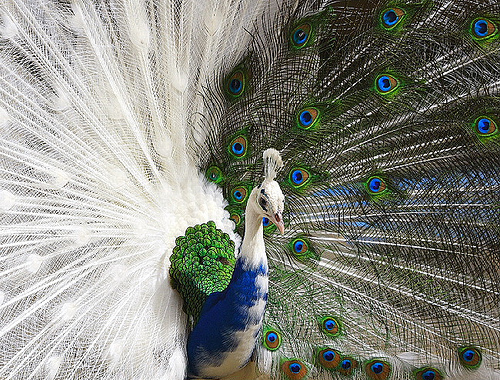As I have been unable to find any kind of scientific consensus on the definitions of “albinism” and “leucism,” I am simply going to call all of these animals “albinos.” But please keep in mind that there are many variations of albinism and how it manifests itself. From the articles I’ve found, it seems that there is even different definitions depending on what taxon you are describing. And so please forgive (or better yet correct!) any errors in claiming these animals to be “true” albinos, as some may fall into a different (although similar) genetic variation.
It is lucky for Claude that he has a home at the California Academy of Sciences because albino alligators don’t survive in the wild. This is due to a number of reasons, the first simply being their complete lack of camouflage. Alligators have a lot of natural predators, especially when they’re under 4 feet long. Claude probably would have been snatched up as a hatchling. Secondly, Claude has no pigment in his skin to protect him from UV rays and so prolonged exposure to sunlight could potentially be harmful to him. And last but not least, because Claude has no pigment in his eyes, he has severely diminished eyesight. In fact, a closer look below will show how he has a few superficial bruises and cuts on his snout from accidentally bumping into the walls. All of these are reasons why albino alligators don’t survive in the wild. As it is, there are less than 50 albino alligators in the entire world and only .001% of baby alligators are hatched albino. This means that you are substantially more likely to be a human born with albinism than an alligator hatched with albinism.

A closer shot of Claude. Note the lack of pigment, even in his eyes. Image taken at the California Academy of Sciences.
Now one thing I think is interesting to note, is that not all albinos are white!

This picture is of an albino cornsnake (the bright orange one with red eyes) intertwined with a non-albino cornsnake. Image taken at the California Academy of Sciences.
“Albino” reptiles are often orange and yellow in color. This is because most of them are amelanistic, or they lack the melanin pigment, but still have their other pigments. (Most mammals don’t have these other pigments, so amelanistic and albino mammals generally look the same.) Many reptile breeders will try to selectively breed albino or “pastel” reptiles.
While we’re on snakes…

La serpiente rey albino. An albino kingsnake. Image taken in a shitty little "Serpentarium" during a festival celebrating Guanacaste Day in Liberia, Costa Rica.
Kingsnakes are probably my favorite type of snake, so despite the location, I was excited to see this guy soaking in a bowl of water.
Now, moving on from reptiles…
Lounging about on her grassy bed, I wonder if Mulali appreciates San Francisco’s fog more than her human companions. Well, it might be easier on her eyes, but the sun’s rays can still pass through fog. So zookeepers have to put sunscreen on her ears, which are the areas most vulnerable to UV rays. This results in a wonderfully comedic moment with a zookeeper, bread in hand, attempting to bribe her over to put on her sunscreen, while she plays hard to get. Pure comedy.
Next up, an animal that is known for its beautiful colors, still looks amazing with all white feathers…

This beauty still has such amazing structure to its feathers, that despite its lack of color, its still stunning. Image taken at the West Coast Game Park Safari in Bandon, Oregon.

A look at the albino peacock's feathers. Image taken at the West Coast Game Park Safari in Bandon, Oregon.
While observing these albino peacocks, it reminded me of images I’ve seen of other peacocks that are not albinos, but lack some pigmentation. I’d thought I’d include it here.
If you liked this, I do recommend visiting Telegraph.co.uk’s albino animal gallery, with amazing albino animals including everything from snowflake, the albino gorilla, to albino blackbirds and vultures, turtles and rays, squirrels and many more. Enjoy!




